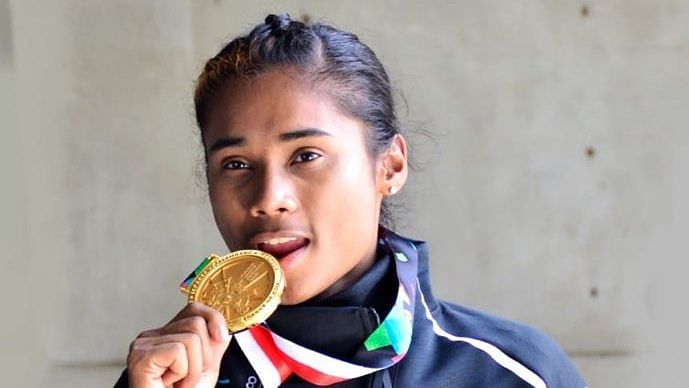New Delhi: India’s medal tally in the 2018 Asian Games is set to increase by one — a bronze — and a silver will be upgraded to a gold as a three-member disciplinary committee of the athletics governing body, the International Association of Athletics Federations (IAAF), has imposed a four-year ban on Bahraini runner Oluwakemi Adekoya for alleged doping.
The committee had on 18 July “impose[d] a period of ineligibility of four-years upon the athlete (Adekoya)” and “ordere[d] the disqualification of any results obtained by the athlete between 24 August 2018 and 26 November 2018 with all resulting consequences, including the forfeiture of any titles, awards, medals, points and appearance money”.
The 2018 Asian Games was held in Indonesia between 18 August and 2 September.
Adekoya was part of the Bahraini 4×400 mixed relay squad that won gold in the Games, pipping the Indian quartet of Mohammad Anas, Hima Das, Arokia Rajiv and M.R. Poovamma. They will now have their medals upgraded to gold. The Indians had lodged an appeal during the Games alleging that a member of the Bahraini team had obstructed Das in the race but they were overruled by a jury.
Adekoya also stands to lose the gold she won for the 400m hurdles at the Games. As a result, India’s Anu Raghavan, who had finished fourth in the race, is set to receive the bronze medal.
The two medals, however, will not improve India’s position on the medal table. The country had finished eighth in the Games with 15 gold medals but Chinese Taipei, which finished seventh, had won 17 golds.
The position on the medal table is determined by the number of golds won.
The long-drawn legal process
The Olympic Council of Asia (OCA), which is the competent authority for deciding consequences at the Games, had disqualified Adekoya’s results in September after a World Anti-Doping Agency accredited laboratory in Doha, Qatar, found the prohibited stanozolol in her urine samples.
Two urine samples had been collected from Adekoya during the Asian Games — the first an out-of-competition sample and the second an In-competition sample after she had won gold in the 400m hurdles final.
OCA’s rules with regards to disqualification in team sports are, however, slightly ambiguous and vary from case to case. For instance, they largely appear to deal with cases where at least two members of a team have violated the anti-doping rule. At the same time, though, the rules also suggest that the OCA may establish some stricter consequences if it prefers.
Regardless of the relevant rule applied by OCA in this case, Adekoya had on 23 October 2018 waived her right for a hearing before OCA and accepted the disqualification of her results.
The four-year ban
The Athletics Integrity Unit (AIU), an arm of the IAAF, and the competent authority for deciding consequences beyond the Games charged Adekoya for violating anti-doping provisions and sought a four-year ban on 4 March this time.
Adekoya contested the charge and requested a hearing through her counsel on 7 March 2019. The appeal went to the AIU’s disciplinary tribunal.
A three-member tribunal, which heard the claims of AIU and Adekoya, found the latter guilty of committing anti-doping rule violations on 18 July.
Also read: These 5 men have been given full responsibility by CoA to pick the Indian cricket team




How are you sure that Hima Das and Dutee Chand is really woman ? Their pelvic bone is narrow which indiate they are Male Pseuco-Hermaphrodite suffering from a genetic disorder CAIS. For example Shanti Soundarajan.